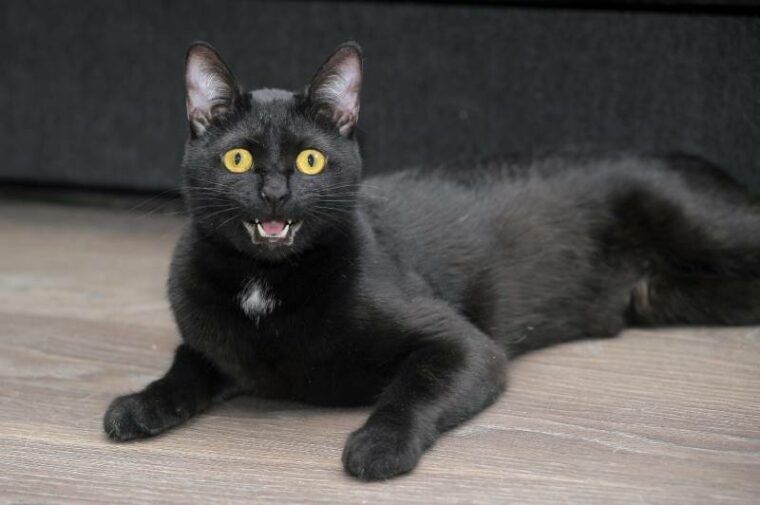
Click to Skip Ahead
Have you ever wandered around your house while your Bombay cat chatted away, almost as if they were telling you their life story? Those are vocalizations! These sleek, black beauties are known for their striking appearance and affectionate nature, but also their tendency to vocalize their needs, wants, and frustrations! In other words, Bombay cats can be chatty. Let’s take a look at some of those vocalizations and what they could potentially mean.
Vocalization in Cats: An Overview
Cats vocalize for a variety of reasons – to express their emotions, communicate with their owners, or signal their physical needs. Sometimes they want attention and often they just want a snack. If you pay attention to your cat long enough, you can start to decode these sounds and why your cat makes them. From meows and purrs to hisses and growls, each sound holds a unique meaning.

The Vocalization of Bombay Cats
So, how vocal are Bombay cats? In general, they are moderately vocal. Unlike some breeds that are known for their constant chatter, Bombay cats tend to use their voice sparingly. However, when they do vocalize, it is usually a sweet, gentle meow used to get your attention or express their needs. Many Bombay cat owners have shared stories of their feline friends greeting them at the door with a soft meow or using their voice to demand cuddles or playtime.
Remember, every cat is unique, and so are their vocalizations. These are general interpretations, and your Bombay cat may use these sounds differently. Always observe the context and body language accompanying these sounds for a better understanding of what your cat is trying to communicate.
The 5 Factors Influencing Bombay Cat’s Vocalization
The vocal behavior of a Bombay cat can be influenced by a multitude of factors, and understanding these can help you better understand your feline friend:
1. Health Issues
Just like humans, cats may become more vocal when they are not feeling well. They could be trying to tell you something’s wrong. Increased vocalization can be a sign of various health issues, ranging from minor discomforts like hairballs or constipation to more serious problems such as urinary tract infections or arthritis. If your Bombay cat suddenly becomes more vocal without any apparent reason, it might be a good idea to consult a vet.

2. Age
Aging can also affect a cat’s vocalization. Older cats may become more vocal due to cognitive issues, hearing loss, or declining vision. They might feel disoriented or anxious, leading to increased meowing or other vocal sounds. It’s also possible that your cat has gotten more comfortable and trusting (and therefore sassier) over time. That can be a good thing! Vocalizations aren’t always about sickness or discomfort.
3. Environmental Changes
Cats are creatures of habit, and changes in their environment can trigger increased vocalization. This could include moving to a new house, the arrival of a new pet or family member, or even rearranging the furniture. Anything that throws off your cat’s daily routine may increase their vocalization.
4. Attention-Seeking
Cats can be quite demanding and will let you know it when they’re not getting enough attention or affection. Your Bombay cat might meow loudly when they want to be petted, or if they haven’t been fed on time.

5. Routine Changes
Changes in their daily routine can also cause increased vocal behavior in Bombay cats. This could be changes in feeding times, playtimes, or even your own schedule. Cats thrive on routine, and disruptions can make them vocalize more to express their displeasure.
Caring for a Vocal Bombay Cat
While Bombay cats are not known for being excessively vocal, they do communicate through sounds, and understanding these sounds is crucial for their care:
Respond Appropriately
When your Bombay cat vocalizes, they are trying to communicate something to you. It’s important to respond appropriately, whether it’s feeding them, playing with them, or just giving them some attention. Ignoring their vocal cues can lead to stress and anxiety.
Provide a Stimulating Environment
Bombay cats are intelligent and active cats. Providing them with a stimulating environment with plenty of toys and playtime can keep them happy and reduce excessive vocalization.
Maintain a Routine
As mentioned earlier, cats thrive on routine. Try to keep a consistent schedule for feeding, playtime, and sleep time. This can provide a sense of security and reduce unnecessary vocalizations.
Regular Vet Check-ups
Regular vet check-ups can help detect any health issues early on, which could be causing increased vocalization. Discuss any changes in your cat’s vocal behavior with your vet.

Conclusion
In conclusion, Bombay cats are moderately vocal, using their voice to communicate their needs and emotions. As an owner, understanding and responding to these vocal cues can greatly enhance your bond with your Bombay cat. And who knows, you might even start to appreciate their gentle, melodic meows as part of their irresistible charm!
Featured Image Credit: Anna Krivitskaya, Shutterstock







